Workflow interaction diagrams
The following are UML diagrams that explain a typical KYC/AML portion of a client or supplier onboarding workflow.
These include calls out to the World-Check One API at relevant points in the workflow, and can be used as a guide to show where the WC1 client’s customer/supplier onboarding system would need to integrate with the World-Check One API to screen and investigate their customers/suppliers.
[ACT-setup]: Initial setup
Initial administration setup within World-Check One to allow API access Zoomable SVG diagram

[ACT-workflow]: KYC/AML workflow summary
Overview of a typical customer/supplier KYC/AML workflow involving the World-Check One API Zoomable SVG diagram
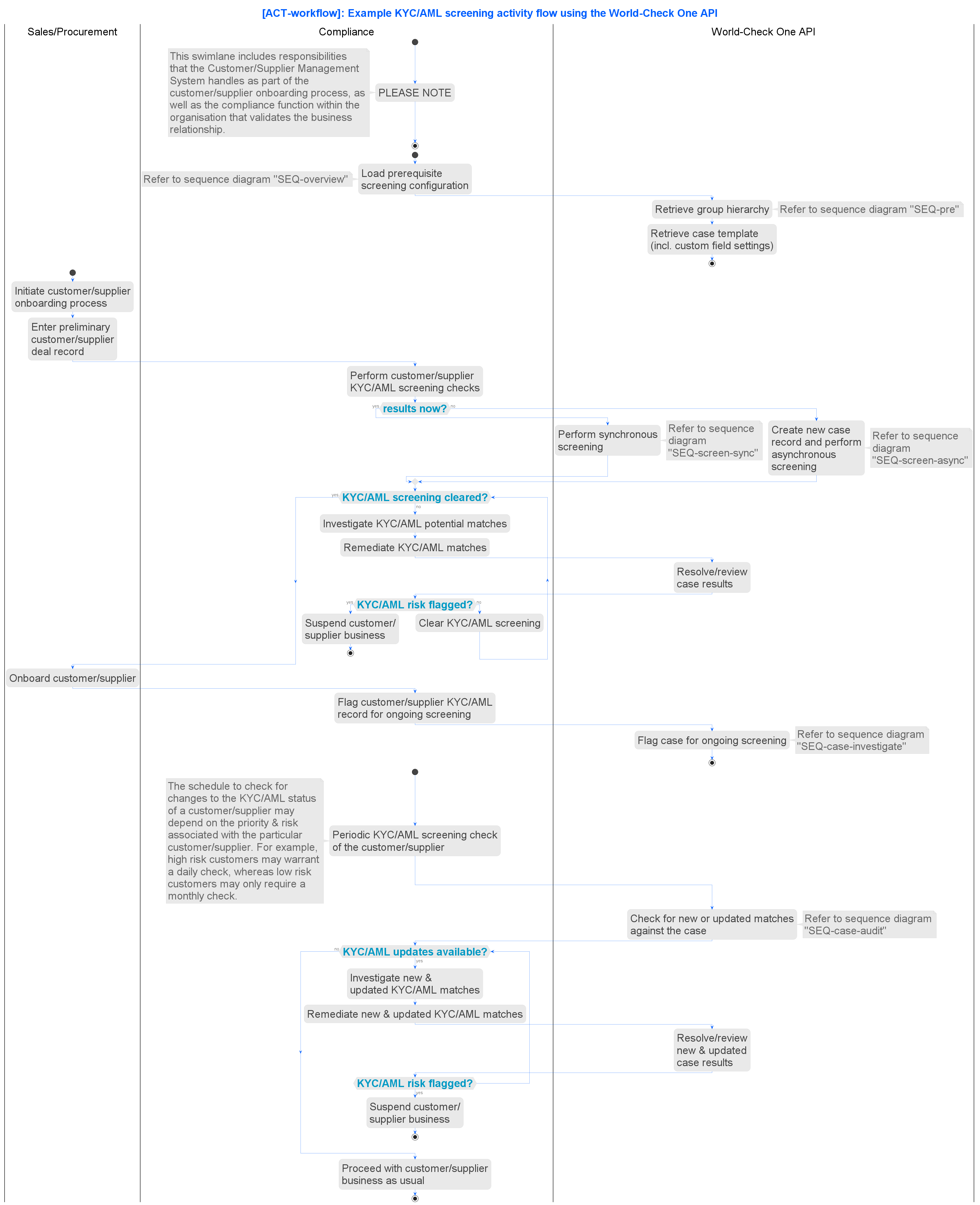
[SEQ-overview]: World-Check One API: high-level interaction overview
Overview of the API calls required to perform all relevant functions available in the World-Check One API Zoomable SVG diagram

[SEQ-pre]: Pre-requisites to creating a new case and working with the case afterwards
Before working with KYC/AML cases within World-Check One, certain pre-requisite data is required Zoomable SVG diagram

[SEQ-case-screening-statuses]: Retrieve case screening status
Users can retrieve screening statuses for multiple cases by POST/cases/screening-status in the initial request. Zoomable SVG diagram

[SEQ-world-check-record]: Retrieve a World-Check Record
[SEQ-world-check-record]: Get a record by its ID
Detailed record information can be retrieved for screening result via the World-Check record ID Zoomable SVG diagram

[SEQ-case]: Perform actions on Case
[SEQ-case-create]: Creating a new case
Store all available fields around a customer/supplier as a case within World-Check One Zoomable SVG diagram

[SEQ-case-retrieve]: Returns case for a given 'caseId'
To interact with cases via the World-Check One API, their system IDs will need to be used Zoomable SVG diagram

[SEQ-case-investigate-details]: Fetch full case details for a given case
To find out what data is currently stored against a specific case within World-Check One API, their system IDs will need to be used Zoomable SVG diagram

[SEQ-case-investigate-results]: Investigating screening results against a case
Once a screening has completed, the results can be obtained and further detailed investigation can be performed Zoomable SVG diagram
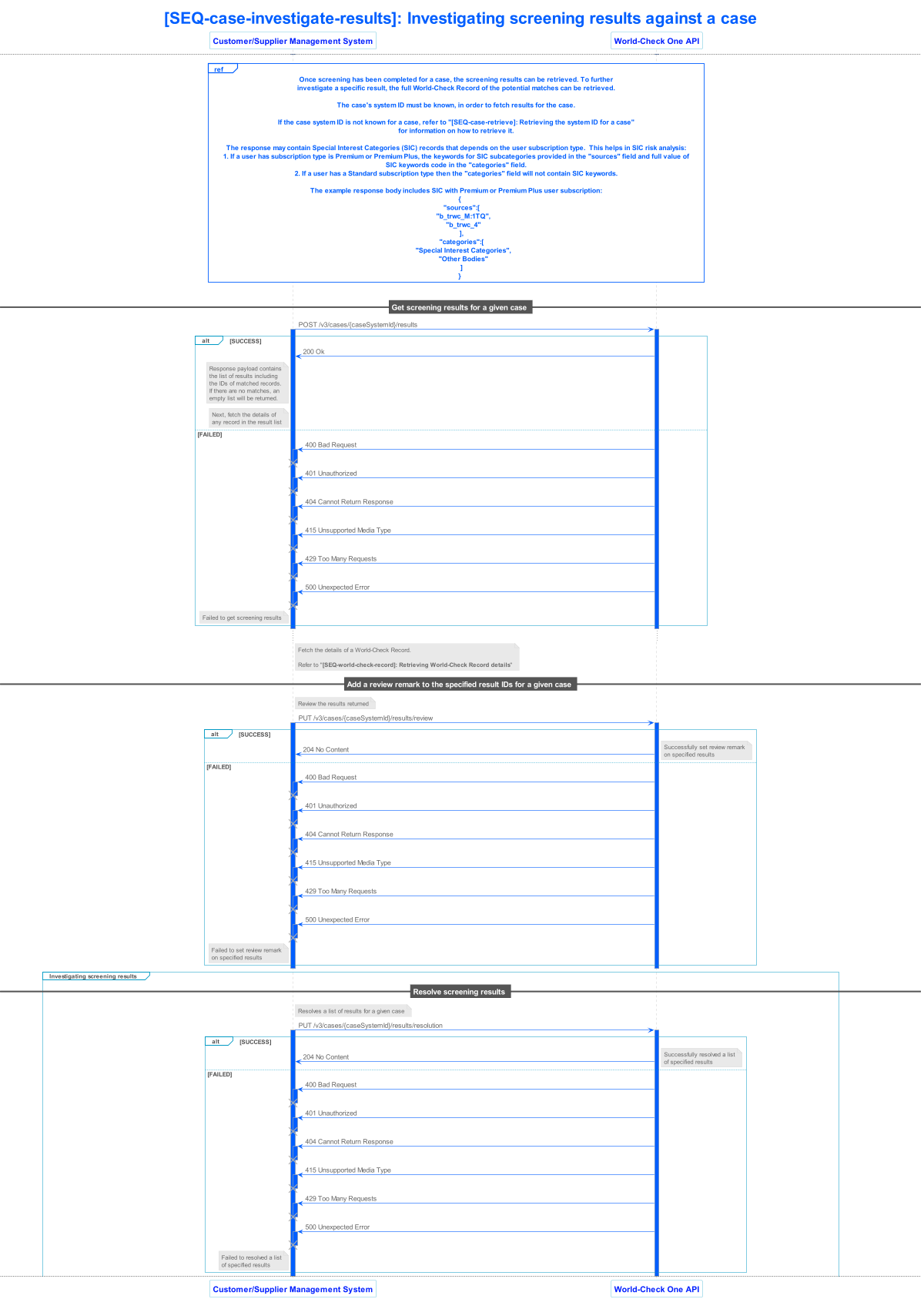
[SEQ-case-ogs-monitoring]: Get ongoing screening updates
Ongoing screening updates to cases over time can be retrieved Zoomable SVG diagram

[SEQ-case-(un)assign]: Assign to a user and unassign a case
A case can be assigned to a user or unassigned from the user Zoomable SVG diagram

[SEQ-case-(un)archive]: Archiving and unarchiving a case
A case can be archived or unarchived. Archiving is a pre-requisite to deleting a case. Zoomable SVG diagram

[SEQ-case-update-partial]: Partial update an existing case by its case
Cases can be partially updated if information about a customer/supplier changes over time, or new information becomes available Zoomable SVG diagram

[SEQ-case-audit]: Get audit events for a given case
Audit information on changes to cases over time can be retrieved Zoomable SVG diagram

[SEQ-case-audit]: Get specific audit event for a given 'auditEventId' belonging to a given case
Get specific audit event for a given auditEventId belonging to a given case Zoomable SVG diagram

[SEQ-case-delete]: Deleting a case
A case can be deleted once it has been archived. Zoomable SVG diagram

[SEQ-case-mediacheck]: Perform Media-Check actions
[SEQ-case-mediacheck-search-results]: Get media-check results for a given case
Once case has been saved, the Media-Check results can be retrieved and scrolled page by page. Zoomable SVG diagram

[SEQ-case-mediacheck-search-results-duplicates]: Retrieve duplicates of media-check articles for a given case
Once Media-Check search results were received, duplicated articles can be retrieved. Zoomable SVG diagram

[SEQ-case-mediacheck-articles-content]: Retrieve media-check articles content for a given case
Once case has been saved and Media-Check results available, articles content can be retrieved. Zoomable SVG diagram

[SEQ-case-mediacheck-articles-attach-detach]: Attach/Detach the articles to/from a given case
Once case has been saved and Media-Check results available, article IDs can be attached. Zoomable SVG diagram
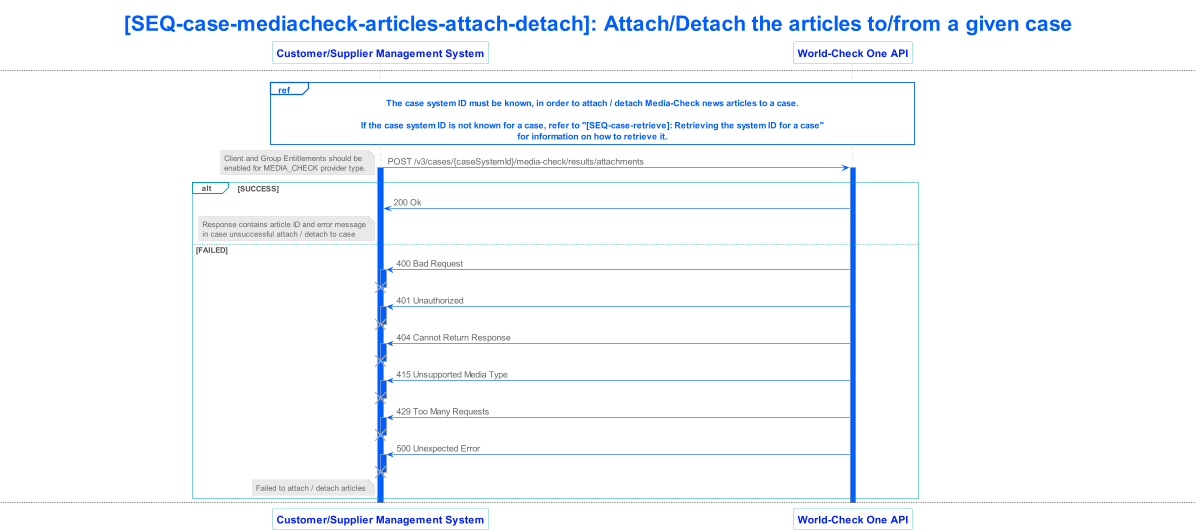
[SEQ-case-mediacheck-articles-attached-retrieve]: Retrieve all attached articles for a given case
Once case has been saved and Media-Check results available, attached articles content can be retrieved. Zoomable SVG diagram

[SEQ-case-mediacheck-results-review]: Mark media-check articles as reviewed for a given case
All articles can be marked as reviewed. Zoomable SVG diagram

[SEQ-cases-bulk-actions]: Perform actions on Bulk Cases
[SEQ-case-save-and-screen-cases]: Save and screen multiple cases
Multiple cases can be saved and screened. Zoomable SVG diagram

[SEQ-cases-bulk-archive]: Archive multiple cases
Cases can be archived or unarchived. Archiving is a pre-requisite to deleting cases. Zoomable SVG diagram

[SEQ-cases-bulk-archive]: Assign multiple cases to a user
Cases can be assigned to or unassign from a user. Zoomable SVG diagram

[SEQ-cases-bulk-delete]: Delete multiple cases
Cases can be deleted once they have been archived. Zoomable SVG diagram
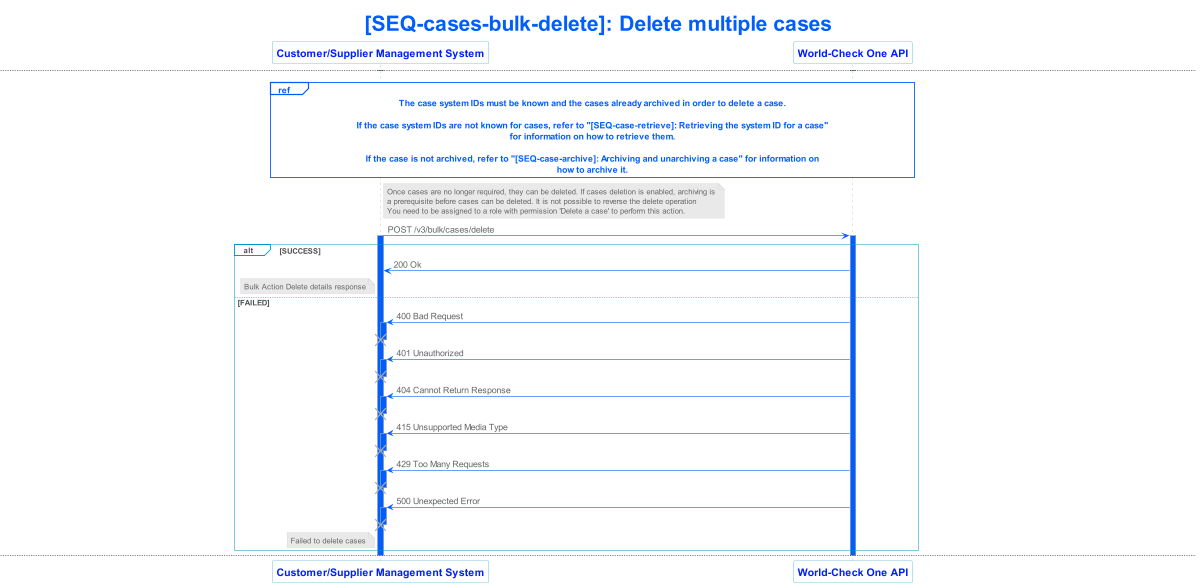
[SEQ-cases-bulk-move]: Move cases to another group
Cases can be moved between groups. Zoomable SVG diagram

[SEQ-cases-bulk-ogs]: Enable/Disable OGS for multiple cases
WC/MC OGS turning ON/OFF can be performed for cases. Zoomable SVG diagram

[SEQ-cases-bulk-link]: Link multiple cases
Cases can be linked or unlinked Zoomable SVG diagram

[SEQ-watchlist]: Watchlist
[SEQ-watchlist-retrieve-provider-source]: Get a list of available providers and their sources
Providers and their sources can be retrieved Zoomable SVG diagram

[SEQ-watchlist-maintain-provider-source]: Create or update a client-watchlist
Provider sources can be created or updated Zoomable SVG diagram

[SEQ-watchlist-maintain]: Maintain client-watchlist data
Watchlist data can be maintained Zoomable SVG diagram

[SEQ-passportcheck]: Perform Passport-Check actions
[SEQ-passportcheck-retrieve-mrz]: Generates MRZ data
Retrieve generated MRZ data Zoomable SVG diagram

[SEQ-passportcheck-verify-mrz]: Verify MRZ lines
Retrieve generated MRZ data Zoomable SVG diagram

[SEQ-linked-cases]: Perform linked cases actions
[SEQ-linked-cases-create-delete-links]: Link cases to a given case
Links between cases can be created Zoomable SVG diagram
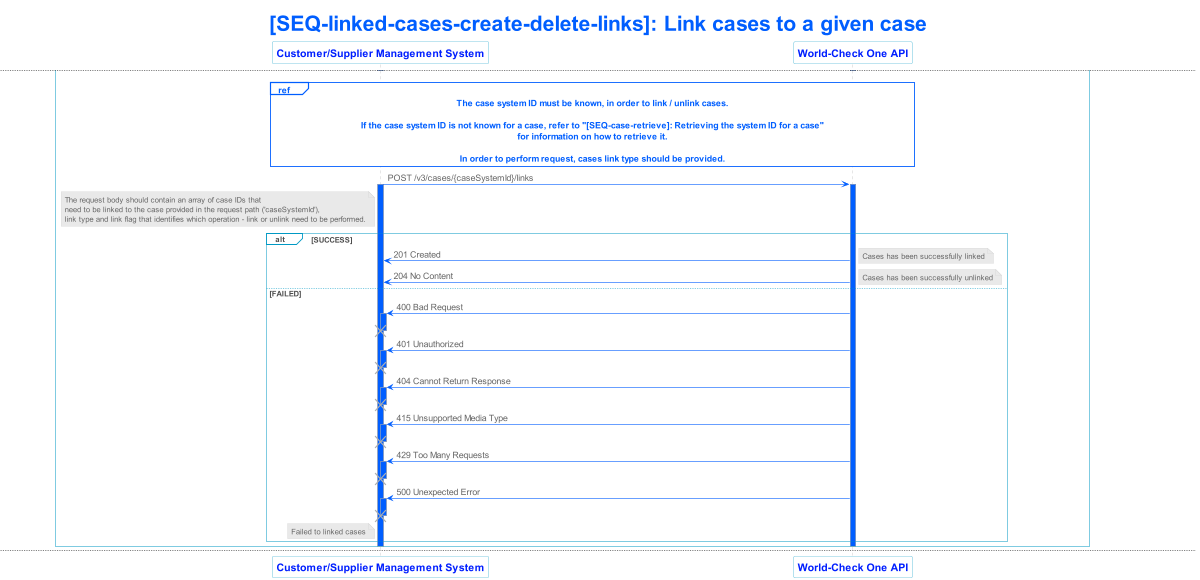
[SEQ-linked-cases-retrieve-case-relationships]: Get linked cases for a given case
Retrieve the list of case relationships with cases linked to it Zoomable SVG diagram

[SEQ-case-rating]: Perform a case rating actions
[SEQ-case-rating]: Get risk rating for a given case
Retrieve a case rating specified on the case Zoomable SVG diagram
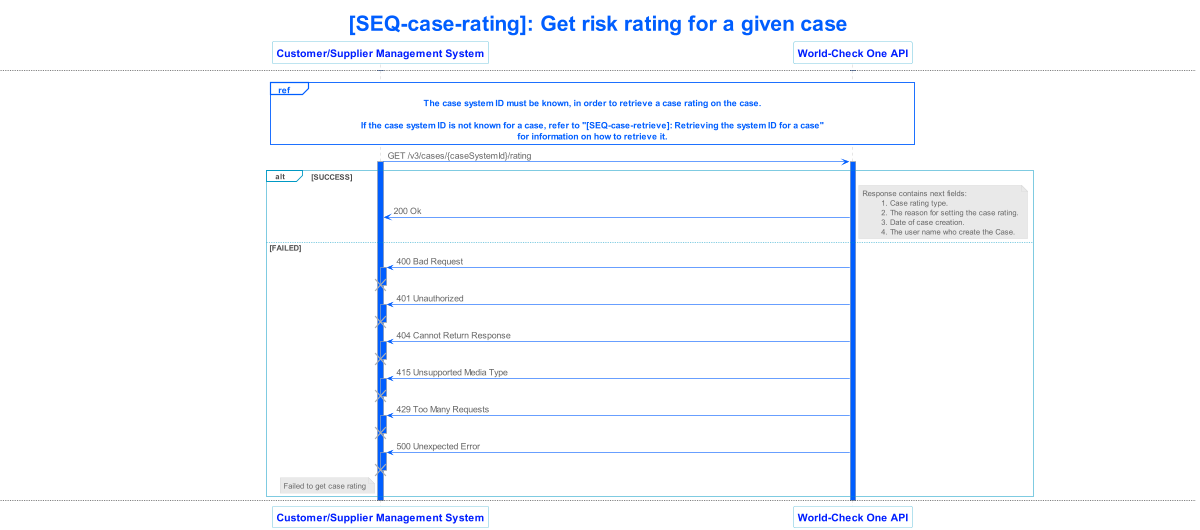
[SEQ-case-rating-maintain]: Search for Cases based on specified criteria
Search for Cases based on specified criteria Zoomable SVG diagram
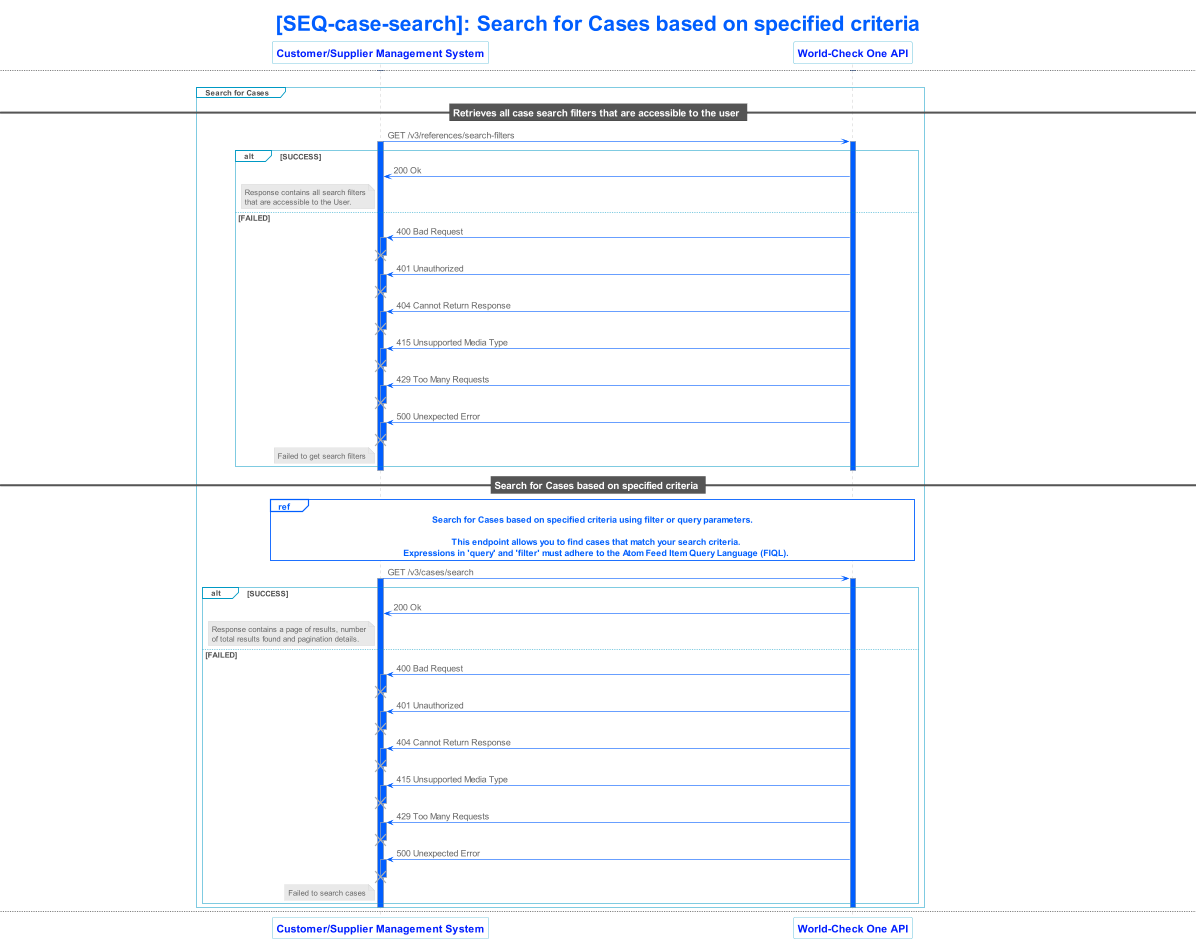
[SEQ-case-report]: Actions for the report domain
[SEQ-async-bulk-report-request]: Submit request for async report based on the given criteria
Request async report can be specified to be able to successfully Submit a report request Zoomable SVG diagram

[SEQ-async-report-status]: Get the report status for the given report ID
Get report status can be specified to be able to successfully get a single report status Zoomable SVG diagram

[SEQ-async-report-statuses]: Get Status of all reports
Get report status for all active reports by pagination params Zoomable SVG diagram

[SEQ-async-report-errors]: Get the error details for the given report ID
Get errors details or errors log for the given reportId Zoomable SVG diagram

[SEQ-async-report-download]: Download the report for given report ID
Download report can be specified to be able to successfully download a report Zoomable SVG diagram
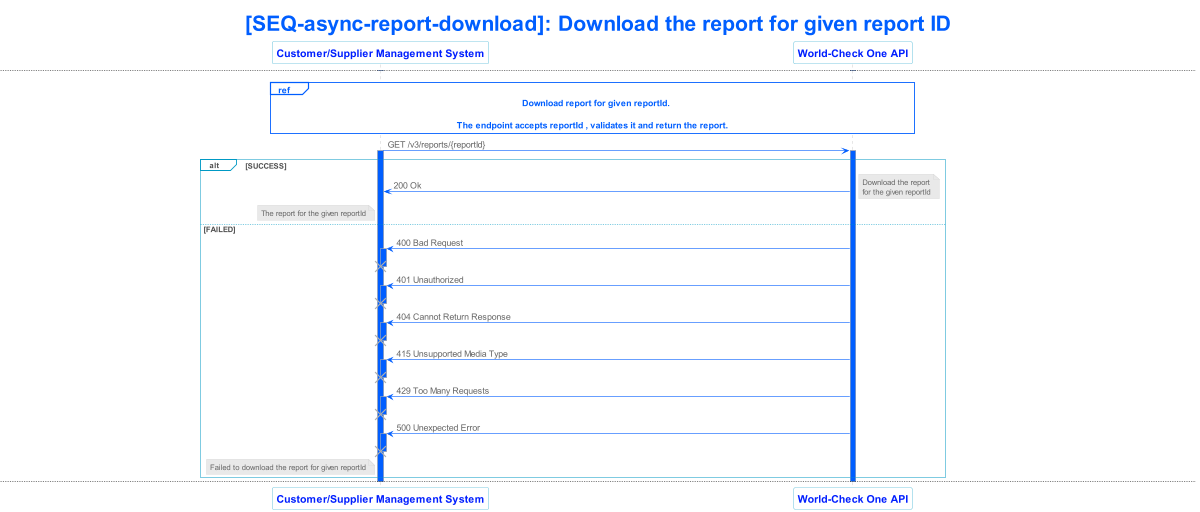
[SEQ-Async-report-cancel]: Cancel the report request for the given report ID
Cancel the submitted async report request by reportId Zoomable SVG diagram

[SEQ-case-ubocheck]: Perform UBO Check actions
[SEQ-case-ubocheck-results]: Get UBO entities for the given caseSystemId
Get UBO entities for the given caseSystemId Zoomable SVG diagram

[SEQ-case-ubocheck-resolve]: Associate the entity with a case or mark all resolved
Associate the entity with a case or mark all resolved Zoomable SVG diagram

[SEQ-case-ubocheck-summary]: Retrieve details of a selected UBO entity
Retrieve details of a selected UBO entity Zoomable SVG diagram

Appendix A: Copyright
(c) 2018 - 2025 LSEG. All rights reserved. Republication or redistribution of LSEG content, including by framing or similar means, is prohibited without the prior written consent of LSEG. 'LSEG' and the LSEG logo are registered trademarks and trademarks of LSEG and its affiliated companies.